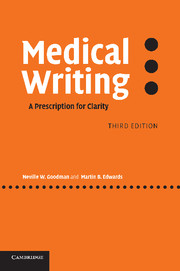Book contents
- Frontmatter
- Contents
- Preface to the first edition
- Preface to the third edition
- Acknowledgements
- PART I PROBLEM: THE ILLNESS
- PART II SOLUTION: SYMPTOMATIC RELIEF
- 3 Guidelines to clearer writing
- 4 Is there a better word?
- 5 Superfluous words
- 6 Imprecise words and phrases
- 7 Superfluous phrases
- 8 Trouble with short words
- 9 Use of the passive voice
- 10 Consistency: number and tenses
- 11 Circumlocution, metaphor and cliché
- 12 Word order and pronouns
- 13 Punctuation
- 14 Constructing sentences
- 15 Drawing clear graphs
- PART III PRACTICE: RECUPERATION
- Appendix: examples to rewrite
- References and further reading
- Index
9 - Use of the passive voice
Published online by Cambridge University Press: 23 November 2009
- Frontmatter
- Contents
- Preface to the first edition
- Preface to the third edition
- Acknowledgements
- PART I PROBLEM: THE ILLNESS
- PART II SOLUTION: SYMPTOMATIC RELIEF
- 3 Guidelines to clearer writing
- 4 Is there a better word?
- 5 Superfluous words
- 6 Imprecise words and phrases
- 7 Superfluous phrases
- 8 Trouble with short words
- 9 Use of the passive voice
- 10 Consistency: number and tenses
- 11 Circumlocution, metaphor and cliché
- 12 Word order and pronouns
- 13 Punctuation
- 14 Constructing sentences
- 15 Drawing clear graphs
- PART III PRACTICE: RECUPERATION
- Appendix: examples to rewrite
- References and further reading
- Index
Summary
Using the active, we write, ‘He made the incision…’ using the passive, ‘The incision was made…’. An established but not absolute convention (see p. 150) was for all scientific writing to be in the passive voice.
Nor need we be deceived by the impersonal passive voice in which such messages [scientific communication] are conventionally cast… The fundamental principle of scientific observation is that all human beings are interchangeable as observers.
Unfortunately, this allegedly fundamental principle (which is increasingly open to question) also makes scientific writing ugly and unwieldy. It is to some extent a matter of fashion, but fashion is now turning against the passive.
When the passive voice is used, the writers take a back seat, as if they had watched the study from a distance: It was decided to; three measurements were taken. The passive forces constructions such as It was necessary to and This necessitated instead of We had to. Medical writers may be reluctant to use the active voice because of a fear that the first person sounds somehow immodest. Used sensibly it does not, but it does lend a paper a directness that gives readers the sense that the writers actually did the work, or hold the opinions, that they describe.
We discussed the therapeutic potential of fish oil in an editorial last year.
This, the first sentence from an unsigned editorial in the Lancet, is more effective than the passive equivalent The therapeutic potential of fish oil was discussed in an editorial in this journal last year.
- Type
- Chapter
- Information
- Medical WritingA Prescription for Clarity, pp. 139 - 144Publisher: Cambridge University PressPrint publication year: 2006



